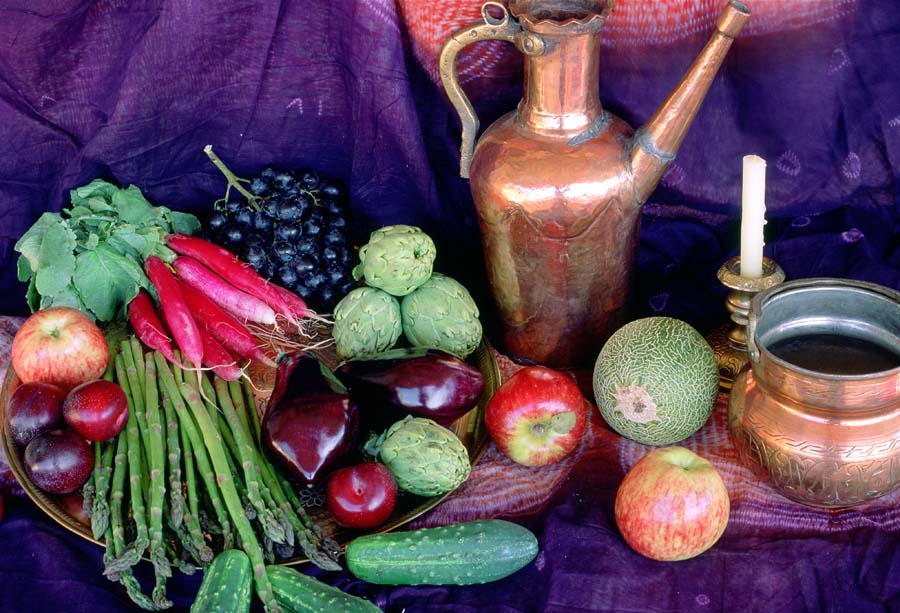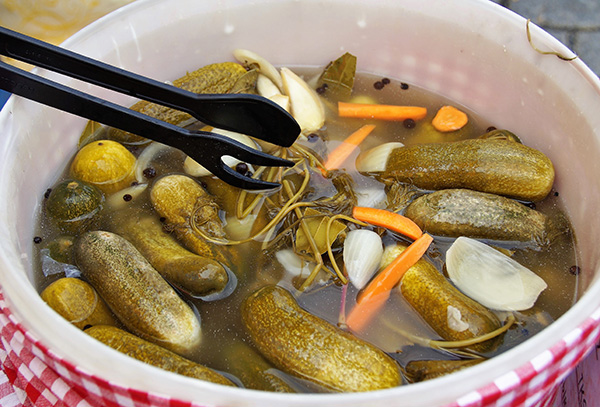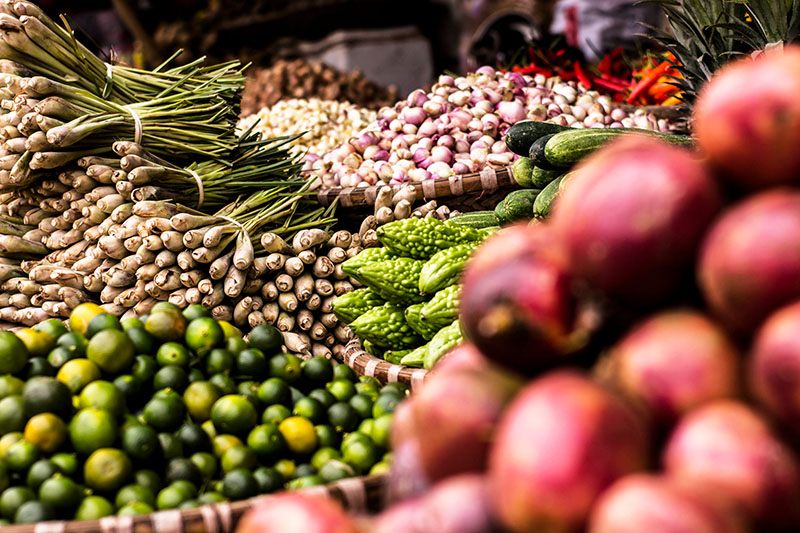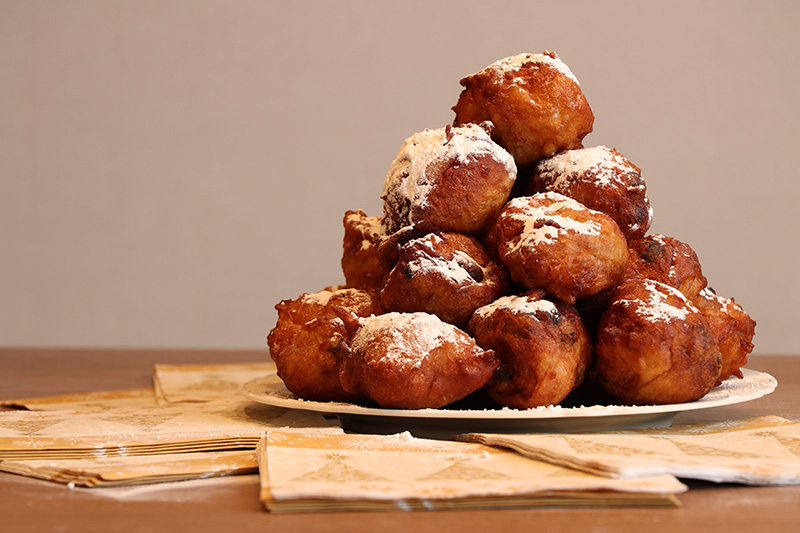Articles
Spices and seasonings in the cuisine of al-Andalus II
Article author: Inés Eléxpuru -FUNCI
Date of publication of the article: 24/11/2023
Year of publication: 2023
Article theme: Al-Andalus, Culinary, Ethnography, History.
PART II
Seasonings
In order to differentiate recipes from one another, to provide a wider range of flavours and at the same time to preserve food, in addition to spices and aromatic herbs, numerous condiments such as oils, vinegars and other sweeteners were used in al-Andalus.
Vinegar, which was considered cold and dry, appears in many recipes, adding a splash of it to sauces. It could be made with apple, pomegranate, citron, white grapes and even rice vinegar. Unripe cedrate fruit was also sometimes used. In fact, many of today’s popular dishes use vinegar to make escabechados (‘pickled, or cooked in oil, and seasoned food’), from the Arabic sikbay, in a clear reminiscence of andalusi. Vinegar was used mainly in fatty and sour dishes. Vinegar was also used for pickling and seasoning artichokes and chicory, together with a dash of oil and spices.
The popular pickles, onions and other pickled vegetables, such as the famous Almagro Aubergines, are still preserved from those times, but not the piperadas (browned peppers and vegetables in oil), as peppers were introduced to our soil after the conquest of America.
In addition to vinegar of various kinds, in al-Andalus, alcaparrado and mostazado, seasoning made with capers and mustard seeds, clarified must, basil, peppermint, sandalwood, apple and quince. Mustard was used to correct the coldness of chard, for example. It was also used to make a sauce by crushing mustard seeds in a mortar or pestle, together with a pinch of almorí and a few peeled almonds.
Almori, from the Latin murri, brine, is perhaps the most widely used condiment in Andalusian cuisine, and appears in many recipes as a seasoning for sauces. It was the direct heir of the Roman garum, a kind of concentrated sauce made from fish entrails fermented in salting, which in al-Andalus could be fish, but also vegetables. But this fish concentrate was not only exclusive to Rome and al-Andalus; it is also very popular in today’s cuisine in the Far East. In fact, in Vietnam and other countries, Nuoc Mam, which is very similar, is still often eaten.
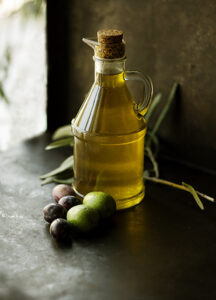 As for the fats, so profusely used in all dishes, butter and mutton fat were used, but above all oil, which could be olive oil, of course, but also sesame, grape seed, almond, wheat and pistachio oil. The extensive cultivation of olive trees that can be seen today in much of Spain dates back to that time, although it was already known in Phoenician and Greek times.
As for the fats, so profusely used in all dishes, butter and mutton fat were used, but above all oil, which could be olive oil, of course, but also sesame, grape seed, almond, wheat and pistachio oil. The extensive cultivation of olive trees that can be seen today in much of Spain dates back to that time, although it was already known in Phoenician and Greek times.
Some of the most popular recipes
Andalusi cuisine was characterised mainly by its opulence and variety. Although, of course, a distinction must be made between palatine, and courtly cuisine, and popular cuisine, which was much simpler and used less protein, although it was not insufficient and poor. It was probably much healthier. The methods of cooking and preparing food were complex and laborious. As today, food was roasted, boiled, fried, pickled and stuffed with other products.
The most elaborate recipes were heavy on fat and protein and calories, as befits any ostentatious cuisine, and also on the complexity of flavours, colours and textures achieved with spices. The appearance of the dishes was very important in this context, which was achieved through the glossiness of the fats and the colour provided by, for example, chopped egg yolks and fresh herbs sprinkled on top of the dishes. Ibn Calih ibn Chayrazad, from the 8th and 9th centuries, expressed it as follows:
“It is fitting that the eye and the nose should have, at a well-served table, an equal share to that found by the palate”.
The great culinary development was brought about by the enormous quantity of products that were then unknown or had disappeared from peninsular soil in pre-Islamic times, which were introduced and acclimatised by the Andalusians, bringing them from the East. The early Muslims, and among them the Andalusians, were characterised by the enormous scientific interest that Islam advocated. Muslims were thus great travellers, and had no qualms about adopting the scientific and cultural achievements that they encountered as they came into contact with other cultures, and then bringing their own imprint, which would result in an extremely rich and original culture.
In this context, many agricultural products were introduced to our soil. We will mention just a few of them, as the list would be endless: aubergine, artichoke, asparagus, peas, chicory and chard, and among the fruit: fig, pomegranate, date, apricot, another word of Arabic origin, watermelon, which came from Sindh, melon, cedrate, lemon, bitter orange, whose peel was used for cosmetic ointments and whose flower was used in perfumery, and many others. The same happened with many of the spices mentioned above.
 Many of the most popular dishes and preparations from the Andalusi period are still preserved in today’s cuisine. For example, we can see how the rice casseroles that are still preserved today in the Levant, with a thousand and one variations, of course. In fact, it is believed that rice was already being cultivated in Visigothic times, but in very small quantities. It was the Andalusi people who extended its cultivation as we can see it today in the Albufera in Valencia and the Aljarafe in Seville. Also from that period are noodles, or fidaws, a word of Mozárabe origin, which were prepared in a similar way to the Levantine fideuà.
Many of the most popular dishes and preparations from the Andalusi period are still preserved in today’s cuisine. For example, we can see how the rice casseroles that are still preserved today in the Levant, with a thousand and one variations, of course. In fact, it is believed that rice was already being cultivated in Visigothic times, but in very small quantities. It was the Andalusi people who extended its cultivation as we can see it today in the Albufera in Valencia and the Aljarafe in Seville. Also from that period are noodles, or fidaws, a word of Mozárabe origin, which were prepared in a similar way to the Levantine fideuà.
Pepitoria is another dish of typical Andalusian origin, with saffron, bay leaves, garlic, chopped almonds and egg yolk for thickening. Almonds, and nuts in general, were also very common in meat stews. The anonymous 13th-century manuscript on Hispano-Magribi cuisine contains, for example, a recipe for hen with almond sauce that reminds us of hen in pepitoria. It was prepared with chopped onion, fresh coriander, cinnamon, vinegar and almorí.
Sausages, minced meats and stuffing were also very characteristic. Pork was not consumed in al-Andalus, although it is said that it continued to be reared by the Mozarabic communities, i.e. the Christians who lived under Muslim rule. However, lamb sausages were made, as can still be seen today in Huesca and La Rioja. These sausages, or mirkas, which were sold in the souks and popular stalls, as is the case today with Maghrebi merguez, were spiced with pepper, lavender and other spices. Another typical minced meat preparation was isfiriya, similar to today’s hamburgers, but seasoned with saffron, cumin and coriander. And it is very curious, because the Andalusian cooks used to bind the meat with egg and breadcrumbs, as is the case today with meatballs, in order to obtain a greater tenderness and tenderness. And speaking of meatballs, this is a dish of 100% Andalusian origin, whose name derives from the Arabic al-bunduq, meaning ‘the bullet’ or ‘the ball’. The difference lies in the spices used to season it.
Stuffing was also typical, as in the incredible recipe called “Carnero relleno por dentro y asado; llamado el completo“ (mutton stuffed inside and roasted; called the complete), which consisted of stuffing a mutton with chickens, pigeons, wood pigeons and fried birds, between the cavities of which were placed sausages, meatballs and egg yolks. But it was also common to stuff fish, geese, aubergines and even asparagus.
Offal was highly prized, especially by the less well-off classes, and today we can testify to the appreciation for it in the cuisine of La Rioja, Andalusia and Madrid, among others.
The offal, or cascasería, was sold in the souks and street stalls, as were certain soups, fried foods and pies.
The anonymous manuscript contains a recipe called Hechura de arcaduz, very similar to today’s chanfaina extremeña, which is prepared with meat, offal, kid fat and egg, and spiced with heather, cinnamon, lavender and pepper.
And let’s not forget fried food, that typically Andalusian tradition. Already in the times of al-Andalus, in the souks and the stalls of the pilgrimages, tejeringos, or churros, fritters, cheese almojábanas and fried fish were sold, which were a special reason for special attention from the almotacén or souk watchman, to prevent rogue traders and products being sold in undesirable conditions. Incidentally, the famous Japanese tempura, which consists of battering and frying vegetables cut into strips or slices, is actually a preparation of Andalusian origin that Japanese fishermen who travelled to the Andalusian Atlantic coast in search of tuna and other fish took with them. In fact, in Huelva and other areas of the Andalusian coast you can eat the so-called ‘calamares de huerta’ which consist of the same thing.
Empanadas were also a classic of the time. The anonymous manuscript contains several recipes, one of which, hake, is delicious, and another, barmaquiya, which was prepared with chicken, along with isfiriyas and meatballs, among other dishes. As you can see, some Andalusian recipes were adopted not only by the Japanese, but even by the Galicians, even though they were never under Muslim rule!
Curiously, one of the characteristics not only of the recipe books of the time, but also of the mentality and culture itself, was the universal and cosmopolitan vision of life and human relations that Andalusian cooks had. In the anonymous recipe book and in other medieval oriental recipe books that have survived, such as that of al-Baghdadi, there are dishes whose names reflect this multicultural spirit, as it is called today. We could also say that they were the pioneers of what is now called fusion cuisine.
These are some of them: Egyptian chicken, Sicilian dish, Syrian sweetmeat, Persian triple farisiya, Jewish partridge and Lamtuniya, which refers to the Berber tribe of the Lamtuna, but there are many, many more.
Fish
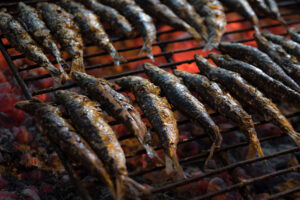 Fish was eaten fried, as well as stewed, roasted and in meatballs, taking a particular shape, as in the recipe for “Almidonado”, in which fish was minced, then shaped into the form of a sardine and fried. The most common seasonings used to prepare the fish were coriander, both green and dried, saffron, pepper and cumin. And the dishes were always garnished with a sprinkling of almorí. The most popular fish were tuna and salmon. But red mullet, hake, whiting, sturgeon, shad and mullet were also popular. Sardines and anchovies from Malaga, which were prepared on a spit and grilled, as they are today, were highly prized. As for eel, which appears in some recipes, it was cooked first and then taken to the communal oven.
Fish was eaten fried, as well as stewed, roasted and in meatballs, taking a particular shape, as in the recipe for “Almidonado”, in which fish was minced, then shaped into the form of a sardine and fried. The most common seasonings used to prepare the fish were coriander, both green and dried, saffron, pepper and cumin. And the dishes were always garnished with a sprinkling of almorí. The most popular fish were tuna and salmon. But red mullet, hake, whiting, sturgeon, shad and mullet were also popular. Sardines and anchovies from Malaga, which were prepared on a spit and grilled, as they are today, were highly prized. As for eel, which appears in some recipes, it was cooked first and then taken to the communal oven.
The roe was also consumed, and was used to make a kind of cake with eggs, reminiscent of the cakes made with scorpion fish and other fish that are made in the Basque Country today. As for mojama, from the Arabic mussaca, dried, it was highly prized.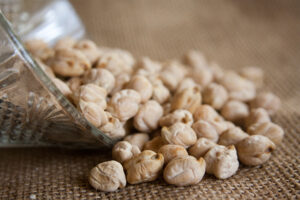
Another of the products used in the cuisine of al-Andalus was legumes: lentils, chickpeas and a certain type of bean, considered nutritious but indigestible. Incidentally, in the Basque Country, beans are called alubias, a direct borrowing from the Arabic al-lubiya. All kinds of eggs were also eaten. They could be chicken, partridge, pigeon or any other kind of poultry, and they could be prepared in many different ways: fried, boiled, in omelettes or as a binder for sauces.
Drinking
The drink consisted basically of water, which was evaluated by dieticians according to its degree of purity, its characteristics and the vessel in which it was contained. Ibn al-Khatib (14th century) recommended not to drink water that “flows through leaden channels and conduits”. As we can see, this statement is fully in line with the present day, as we all know that lead is toxic. And the fact is that the water pipes, as we have been able to see for example in the palatine city of Medina Azahara, near Cordoba, had extensive and highly complex lead sewage systems. And we are talking about the 9th century. But in addition to water, other drinks were also drunk, such as mead, recommended by the Prophet, and tiger nut milk (horchata de chufas).
As for fermented beverages, as noted above (Part I), they were more than popular. Not only were wine and beer drunk at high society gatherings, although these concoctions had little to do with those known today, but some authors such as Ibn al-Awwam (12th-13th century), describe how to prepare a kind of sweet wine, and the Granada author Ibn al-Khatib in his Book of Hygiene, ponders the virtues of the different kinds of wine, saying, among many other things, that,
“They warm the body, stomach and liver, make the urine flow and loosen the belly”.
If, in addition, according to this same author, we add delirious medicines in them, we will see that,
“they generate joy, expel gas and increase sexual potency”.
But not all Andalusian authors and physicians were as free-thinking as Ibn al-Khatib. Averroes, who in addition to being an excellent philosopher was also a renowned physician, said in this regard:
“One should not drink too much, nor should one drink every day; it is harmful to drink wine on an empty stomach. To get drunk once a month is a mistake. A little would be good for the elderly and old people. The wine that produces the greatest amount of gas is the pure one, and especially the dark ones”.
As we can see, Averroes is more moderate, but not opposed to its ingestion.
Confectionery
But it is in modern Spanish confectionery that the Andalusian influence is most noticeable. Curiously, this influence is particularly evident in convent sweets and those associated with certain Christian festivities, such as turrón, marzipan and alfajores.
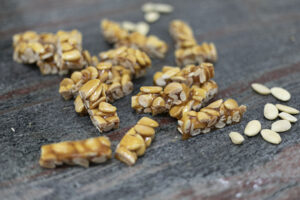 As is the case today, the Arabs were fond of sweet and cloying flavours. Their confectionery was complex and based on the use of honey and sugar, of course, but also butter, almond oil and dried fruits: almonds, walnuts, pine nuts, pistachios, or alfoncigos, to use an Arabic word. They were flavoured with rose water, orange blossom water, nutmeg, cloves, pepper and cinnamon.
As is the case today, the Arabs were fond of sweet and cloying flavours. Their confectionery was complex and based on the use of honey and sugar, of course, but also butter, almond oil and dried fruits: almonds, walnuts, pine nuts, pistachios, or alfoncigos, to use an Arabic word. They were flavoured with rose water, orange blossom water, nutmeg, cloves, pepper and cinnamon.
Sweets made with dates, the quintessential food of the Arabian desert, which the Muslims cultivated in Elche, as we can still see in its superb palm grove, were also very popular. Among them were the markaba and the alcorza de dátiles, typical of North Africa.
Ibn al-Awwam, in his Book of Agriculture, recommended that:
“If the situation requires it, the ingestion of these sweets should be compensated by taking lime vinegar, acids and bitter pomegranate, as it is not good to eat sweets”.
All this fabulous sweet heritage is still evident in today’s confectionery. In the guirlache of Aragon, the alajú of Cuenca, the almojábanas de queso, the alfeñiques of Extremadura, the piñonate of Huelva, the buñuelos and the pestiños, to name but a few. And let’s not forget, of course, rice pudding, which the Asturians are so fond of, for example. This unctuous and calorific dessert was a hundred percent Andalusian invention, as can be seen in the recipe from the 13th century. The only difference was that a knob of fresh butter was added and it could be made with honey instead of sugar. But everything else was exactly the same.
And we could end by saying that the gastronomy of al-Andalus was so refined and sybaritic that, in some cases, as can be seen in this poem by Ben Mas’ud, from the 11th century, love was preferred to pleasure:
“What an empire is worth is a tafaya cake of fattened and exquisite hens.
If I were asked: “Who are you in love with and why do you shed so many tears?
I would say: “For the pickle, for the yummuliya and for a roast of tender lamb with fine bread leaves.
A gruel of semolina is sweeter to me than the saliva of the beloved when I squeeze him”.
Bibliography
Albarracín, J., Martínez, J. Medicina, farmacopea y magia en el “Misceláneo de Salomón”, Granada, 1987.
Al Razi, Abu Bakr Muhammad b. Zakariya, Libro de la introducción al arte de la medicina o “Isagoge”, trad. Vázquez de Benito, M. Salamanca, 1979.
Ben al-Jatib, Muhammad b. Abdallah, K., al-Wusul li-hifz al-sihha fi-l-fusul “Libro de la Higiene”, trad. trad. Vázquez de Benito, M. Salamanca, 1984.
Bolens, L., “La révolution agricole andalouse du XIe siècle”, Studia Islamica, XLVII, París, 1978.
Chalmeta, P., El señor del zoco en España, Madrid, 1973.
De La Granja, F., “La cocina arabigoandaluza según un manuscrito inédito: Fadalat al-Jiwan”, extracto de tesis, Madrid, 1960.
Eléxpuru, I. y Serrano, M., “Al-Andalus, magia y seducción culinarias”, Madrid, 1991.
Eléxpuru, I., “La cocina de al-Andalus”, Madrid, 1994.
García Sánchez, E., “Ibn al-Azraq: Uryuza sobre ciertas preferencias gastronómicas de los granadinos”, tirada aparte de Andalucía Islámica, I, pp.141-162, Granada, 1980.
Huici Miranda, A., Traducción española de un manuscrito anónimo del siglo XIII sobre la cocina hispano-magribí, Madrid, 1966.
Ibn al-Awam, Libro de Agricultura, trad. Banqueri, Madrid, 1802, edición facsímil, Madrid, 1988, I-II.
Ibn Bassal, Libro de Agricultura, trad. Millás Vallicrosa, M., Aziman, Tetuán, 1955.
Ibn Wafid, El Libro de la Almohada, trad. Álvarez de Morales, C., Toledo, 1981.
Marín, M., “Las plantas alimenticias y su utilización en una manuscrito oriental sobre alimentación y dietética”, Ciencias de la naturaleza en al-Andalus, I, Granada, 1990.
Millás Vallicrosa, J., “Los geóponos hispanoárabes”, Revista del Instituto egipcio de estudios islámicos en Madrid, vol. VI, fasc. 1-2, Madrid, 1957.


